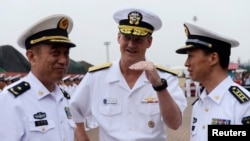A close encounter last week between a U.S. surveillance plane and a Chinese fighter jet shows the need for greater military cooperation and agreed upon rules of engagement between the two countries, analysts say.
The Pentagon said the U.S. Navy’s P-8A Poseidon was in international airspace, about 200 kilometers east of China's southern island of Hainan, when it was confronted by the Chinese jet last Tuesday.
The Shenyang J-11B fighter crossed beneath the U.S. plane three times and exposed its belly in an apparent attempt to show off its weapons load, according to Pentagon spokesman Rear Admiral John Kirby. At one point, he said, the jet's wings came within nine meters of those of the U.S. plane.
Kirby called the Chinese pilot’s actions "aggressive" and "unprofessional" and said the Pentagon expressed to Beijing its “strong objection” with regards to the maneuver.
The Chinese Defense Ministry called the criticism “totally groundless.” In a statement, it insisted the pilot acted professionally and kept a safe distance. The statement said any blame for the incident lies with the American plane and demanded the U.S. stop conducting reconnaissance missions near China.
The incident was reminiscent of 2001, when a similar maneuver by a Chinese pilot resulted in a mid-air collision between a Chinese J-8 fighter jet and a U.S. Navy EP-3 spy plane. That crash killed the Chinese pilot and forced the U.S. plane to make an emergency landing on Hainan, prompting a major diplomatic crisis.
Risk of more mid-air encouters
Many defense analysts expect to see more dangerous mid-air encounters as China’s military grows stronger and becomes more uncomfortable with a U.S. military presence so close to its territory.
"China feels it has the rights of a certain strategic space around its borders. It doesn't fly planes close to the borders of the United States and so it feels, 'Well, why is it that we have American forces so close to us?'” said Kerry Brown, a former British diplomat in Beijing who now heads the University of Sydney's China Studies Center.
Brown said close encounters last like week’s are “incredibly dangerous,” not only for the pilots and other forces directly involved, but because the incidents could spiral out of control diplomatically. “That’s exactly the kind of scenario where you can see things totally escalating,” he said.
U.S. and Chinese officials have both made public calls for more military cooperation and dialogue in order to lessen tensions and increase understanding, and most say progress is being made on this front.
The most recent talks occurred this week, when the Pentagon said U.S. and Chinese officials met in Washington as part of long-planned discussions on air and sea behavior. U.S. officials told VOA that last week’s close call was discussed in the talks.
But Brown said that so far, such talks have not done enough.
“You have attempts at that kind of dialogue, but it’s not that structured. And that really needs to be in place so that each side understands where the red lines are. The problem at the moment is that there isn't a great deal of understanding on the Chinese side of where the American red lines are. And American defense officials might think that everyone's very, very clear on the Chinese side, but it's clear that there’s a communication issue,” he said.
Need to establish mutually accepted rules
Establishing mutually and internationally accepted rules of behavior is another way to reduce the chances of a significant escalation, said Australian National University Asia defense specialist John Blaxland.
"There needs to be established protocols. We've seen calls for this in the South China Sea. ASEAN (The Association of Southeast Asian Nations) has been calling for a code of conduct arrangements for vessels at sea. I think the same goes for aircraft,” he said.
But there are questions about whether China is willing to respect international laws and customs when they conflict with its interests and historical claims. Blaxland suggests China’s provocative behavior may indicate that it wants to “rewrite the rules” that have been commonly agreed to internationally.
“Their approach has been really pretty aggressive and unfriendly toward a number of countries. It has not sought to engage on a consensus basis. It's trying to pick off the Philippines, it's tried to pick off Vietnam, and now it's trying to pick off individual aircraft, and we've seen that against U.S. vessels as well. This is a really combative approach, it's not an approach that attempts to find consensus through mutually recognized procedures," he said.
U.S. military officials and policymakers must also decide whether it is worth it to continue asserting American naval and air power so close to China’s shores, when it is clear that this will irritate Beijing and could lead to confrontation.
“Perhaps some concession can be made here (by the U.S.),” said Blaxland. “The other side here is that if you make that concession, will it lead to even greater concessions?”




